I chuckled when reading up on the history of these Chinese crullers, you tiao (油条), which have been localized in Thailand into Pa Thong Ko (ปาท่องโก๋).
According to the widely-circulated Chinese folk etymology, these pairs of dough sticks apparently represent two evil people who deserve to suffer in hot oil. To the Thai people, the conjoined crullers represent something cuter and more romantic: a couple who are deeply attached to one another and seen together all the time. Symbols and figures of speech behave like that across the various cultures. The Zealous Water Buffalo, my alter ego, has written about these things.
Another funny thing about Pa Thong Ko: it is a misnomer resulted from confusion on the Thai’s part over the various goodies sold by Chinese immigrants from years ago; it’s not even a localized pronunciation of the original Chinese, but a wrong name altogether. We could have gone with something close to you char kway (油炸粿) or something similar to that as the Chinese words that have entered our vernacular often come from the Hokkien or Teochew dialects. But, apparently, a mistake was made a while back and it has stuck with us ever since. In other words, unless you speak to someone who knows Chinese, your inquiry about youtiao or you char kway in Thailand will be met with a,”Huh?“
More differences.
Pa Thong Ko comes in smaller size — generally around 3-4 inches in length whereas youtiao could be as long as a couple of feet. Also, when I was growing up — maybe it’s my imagination — Pa Thong Ko seemed to resemble their Chinese prototype more both in terms of appearance (blistered, bubbly, crispy exterior) and texture (soft and slightly chewy with honeycomb-like crumb). These days, they seem to have morphed into crullers that look smoother on the surface, more crusty than crispy on the outside, and doughy on the inside. Rarely do you find Pa Thong Ko made the way they were years ago. (I’m not complaining; I’m just reporting what I’ve found. In fact, what you see here is my attempt at replicating Pa Thong Ko as they are made these days, albeit more crispy than crusty.)
Also, the Thai people like to eat these crullers with sweetened condensed milk, coffee, or dipping custard, Sangkhaya (สังขยา). They are also served with Chinese congee, jok (โจ๊ก).
Note that there’s another kind of fried dough that is also called Pa Thong Ko, but it’s almost entirely different from what’s in view here. This type of Pa Thong Ko is smaller, fried until thoroughly crispy, and served as an accompaniment to Chinese-style soybean curd in warm ginger syrup (เต้าฮวยน้ำขิง).
Enough with the background information. Let’s talk about how to make these crullers.
First of all — and this may sound harsh — assuming my opinion means anything to you: if you see recipes for Pa Thong Ko that don’t call for both baking ammonia and alum powder, I wouldn’t even think about messing around with them. I’m serious. That’s the whole point of being a recipe tester: I waste my time and money, so you won’t have to. And, boy, did I do just that. With just baking powder, your Pa Thong Ko will be doughnut-like, and you and I both know Pa Thong Ko aren’t doughnut-like. With just baking soda, your Pa Thong Ko come out crusty (as opposed to crispy) on the outside and hollow on the inside. Again, we both know that doesn’t describe good Pa Thong Ko.
My recipe takes no chances. It has ammonia, alum, and yeast. Baking powder is added at the last stage just before the dough is formed to give it a lift in the deep-fryer. The result is Pa Thong Ko with open crumb (but not hollow) and crispy exterior. When you bite into one, it collapses between your teeth. No bouncy resistance as is the case with yeast doughnuts.
The ammonia also gives the crullers that familiar scent that’s just faint enough to be pleasantly reminiscent of Pa Thong Ko from the streets of Bangkok, but not so strong that it reminds you of … I’ll shut up now.
I’ll admit, though, that even though this recipe represents my best attempt to date, I still won’t give it an A or an A+. Maybe a B+. I’m satisfied with the texture and flavor, but shaping the dough into pairs of Pa Thong Ko in a uniformed manner is still a struggle for me.
This is because the dough is wet. It has to be wet; otherwise, you won’t get the open crumb. Adding more flour to the dough defeats this purpose. Keeping the flour at this amount presents a bit of a problem for an amateur Pa Thong Ko maker like me as the two pieces of dough tend to merge together a little too seamlessly. You see, well-formed pairs of Pa Thong Ko kind of have to remain visibly two separate entities conjoined in the middle. It’s going to take some practice.
I don’t even try to come up with a more creative way of shaping Pa Thong Ko. Forget dragon-shaped Pa Thong Ko or dinosaur-shaped Pa Thong Ko; I have a hard enough time making the classic shape.
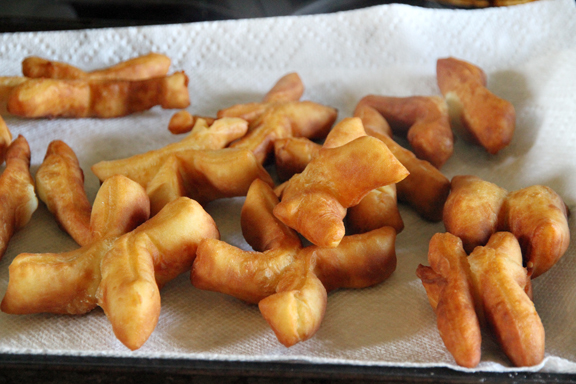
The rest is pretty easy, actually. The recipe has produced very consistent results for me during the past several months of testing and retesting. Be sure to secure all the necessary ingredients. Alum powder is found either in the spice aisle or canning aisle. Ammonia powder is a little harder to find at a local supermarket, but you can find it online easily.
Lastly, have some sweetened condensed milk around — like I need to tell you that — to dip these crullers in. I don’t care much for Pa Thong Ko dipped in Thai dipping custard (sangkhaya), but sweetened condensed milk — hohohohohoho.
- 260g (about 2 cups and 3 tablespoons) bread flour, plus more for dusting
- 170g (3/4 cup) lukewarm water (100-110 degrees F)
- 2g (1 teaspoon) active dry yeast
- 2g (1 teaspoon) baking ammonia (see notes)
- ½ teaspoon alum powder (see notes)
- 8g (1½ teaspoons) salt
- 14g (1 tablespoon) granulated sugar
- 1 tablespoon vegetable oil
- 4g (2 teaspoons) baking powder
- Add all the ingredients, except baking powder, into the bowl of an electric mixer attached with a dough hook; mix on medium-high for 8-10 minutes. The dough will be quite wet, and you may be tempted to add more flour to it. Don't. The moisture in the dough is what creates steam inside the crullers when they're in the hot oil. Besides, once the dough has rested, it becomes a bit firmer and more manageable.
- Put about 2 tablespoons of vegetable oil (additional to 1 tablespoon in the dough) into a separate bowl and rub the bottom of the bowl with it. With oiled hands, form the dough into a round ball as best as you can. If you can't turn it into a smooth ball, don't worry. It doesn't matter. Make sure the dough ball is covered with oil.
- Cover the bowl with a kitchen towel and let it rest for 4-5 hours.
- After 4-5 hours, you will see that dough has not risen much, if at all; no worries. Everything's fine.
- Take the dough out onto your kitchen counter which has been dusted with more flour. Spread it out with your hands. Sprinkle the baking powder all over the surface of the dough.
- Fold the dough in half over itself and push it slightly forward with the heels of your hands. Give the dough a quarter turn; repeat with the folding and stretching 3-4 more times.
- Once the baking powder has been incorporated into the dough, form the dough into a ball.
- Cut the ball in half.
- Working with one half at a time (keep the other half covered), spread the dough out with your hands and pat it down until you get an 8x5-inch rectangle.
- Cut the rectangle in half lengthwise into 8 strips of equal size, then cut the 8 strips crosswise in half.
- Repeat the process with remaining dough.
- Heat some vegetable oil in a fryer, making sure the oil is at least 3 inches deep.
- While waiting for the oil to heat up, get a bowl of water and start making conjoined dough twins. You do that by rubbing some water in the middle of one piece of dough (covering about an inch) on top of another piece of dough and pressing the two together at the spot where the water is. Arrange them on a platter in a single layer. Repeat until you've run out of dough strips.
- Once the oil reaches 350 degrees F (if you don't have a thermometer, do a chopstick test by pressing the tip of a wooden chopstick against the bottom of the fryer. If you see bubbles, the oil is ready), gently lower the twins into it. Don't crowd the fryer. You don't want the oil temperature to drop too quickly, and you want to have enough room to flip the twins around.
- Flip the twins around (did I just repeat myself?) constantly (This is easy to do with a pair of wooden chopsticks.) until they have puffed up and become golden brown all over.
- Fish them out onto a paper towel-lined cookie sheet. Arrange them in a single layer.
- Consume when slightly warm. Serve with sweetened condensed milk or Thai dipping custard (sangkhaya).







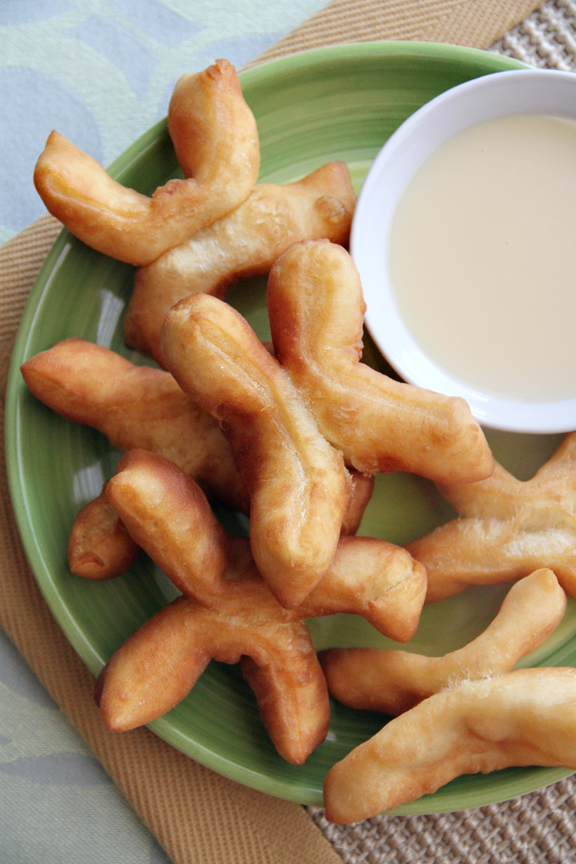
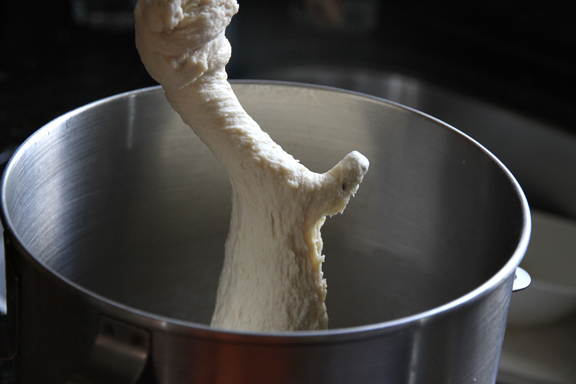
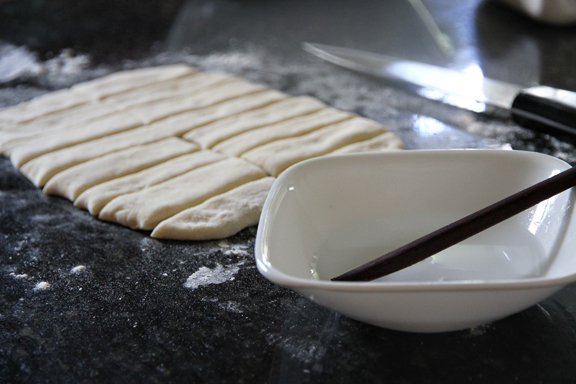
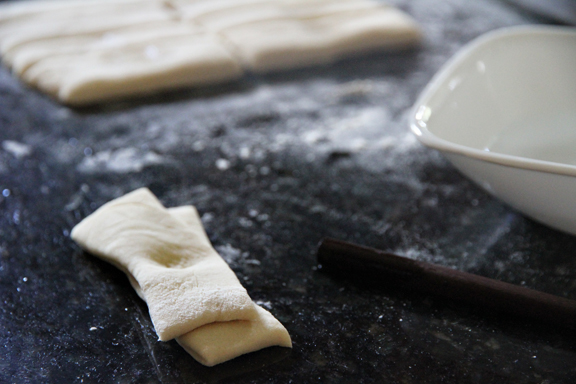
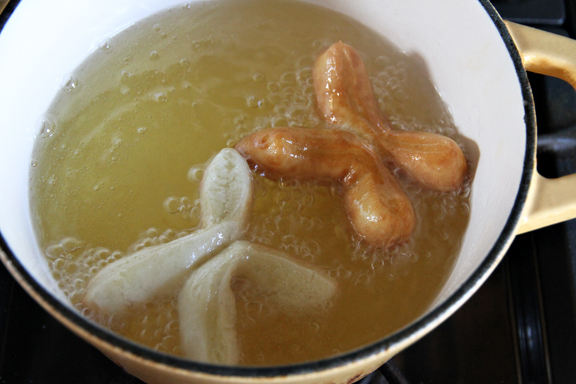
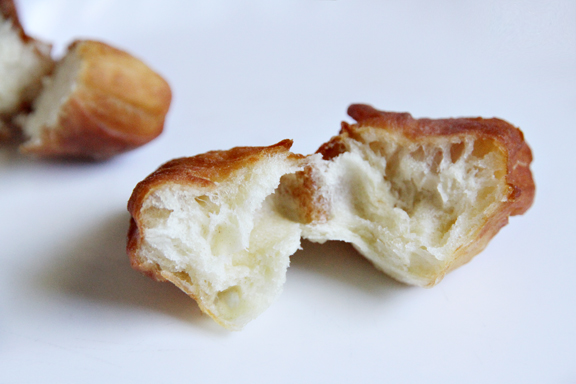

30 Responses to Pa Thong Ko: Thai-Style Chinese Crullers (ปาท่องโก๋)